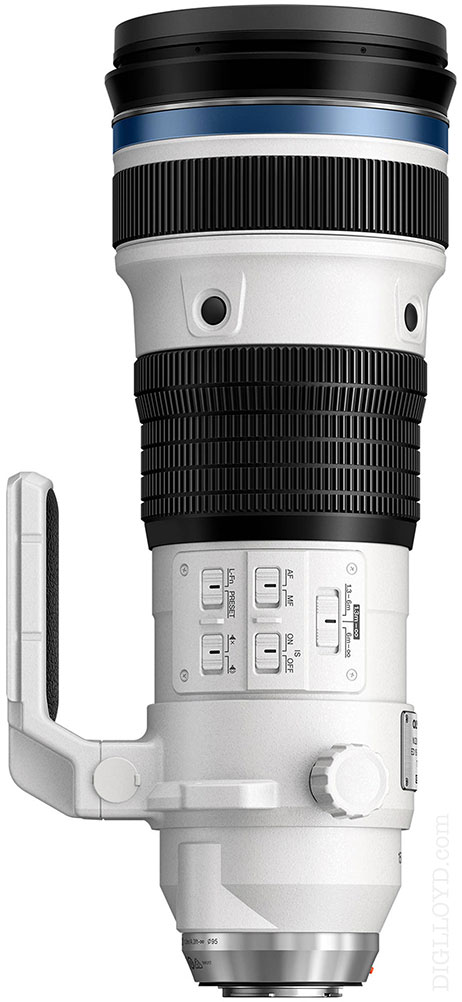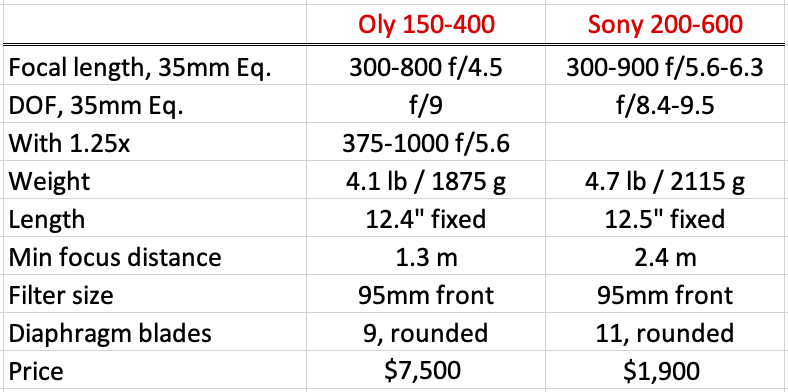The Most Useful and Practical Telephoto for Wildlife Might Be the Olympus M.Zuiko Digital ED 150-400mm f/4.5 TC1.25X IS PRO
re: Inexpensive Camera for Wildlife: Olympus E-M1 Mark II + Reader Comments, including the reader comments.
re: Cropping a Full-Frame 35mm-Format Camera for Longer Reach, vs APS-C and Micro Four Thirds

UPDATE March 7: more reader comments added, scroll down.
Each spring and fall in particular, I feel a little frustrated with lacking the reach to get some good images. For example, here in spring a Great Blue Heron regularly lands about 80 feet out my office window (looking for gophers). I’d love to get some images but this bird is extremely skittish; just exiting the house and off s/he goes. All these years, and not one acceptable image. Yet I could shoot right out my office window (swing-open windows).
Great Blue Heron diet — Highly variable and adaptable. Eats mostly fish, but also frogs, salamanders, turtles, snakes, insects, rodents, birds. Has been seen stalking voles and gophers in fields, capturing rails at edge of marsh, eating many species of small waterbirds.
But the longest lens I have for the Olympus E-M1 Mark II is the Olympus ZUIKO SHG 35-100mm f/2 ED. A world class lens, but it only gets out to 200mm equivalent, and I need more like 800mm for such birds or other wildlife that size and smaller.
That’s why I’d love to own the Olympus M.Zuiko Digital ED 150-400mm f/4.5 TC1.25X IS PRO. Not just for home, but it would be great for all sorts of grab-n-click shots in the outdoors, with plenty of opportunities right out the van window.
Even without its built-in 1.25X teleconverter, the 150-400mm is the equivalent of about a 312-832mm. With the teleconverter, about a 400-1000mm and it’s still at f/5.6, which is slow but acceptable. On the E-M1 Mark II, handholding with quality is feasible too, what with the optical image stabilization and the IBIS.
James M, a wildlife photographer since 1949, writes:
I have used the Olympus M.ZUIKO 300mm f/4 IS PRO for several years and it has never let me down. The upcoming Olympus 150-400mm f/4.5 IS lens may be an additional reason, but I have yet to see a critical review. For less than 300mm there are many good lens options. I often use the Panasonic Lumix 42.5mm f1.2 ASPH.
DIGLLOYD: yep the 150-400mm is the ticket, and those other lenses are great too.
Is a 20-megapixel sensor enough for wildlife? I think so, but take a look at the image below and see what you think. Thing is, depth of field is a major consideration (double on Micro Four Thirds at the same aperture), and if you have twice the reach and/or can handhold shots, you get a lot more winning shots much more easily. Try shooting one of the full-frame super-telephotos—major PITA in practical terms.
Please use these links to buy, thank you.

|

|

$700 SAVE $200 = 22.0% Olympus 75mm f/1.8 M.Zuiko Digital ED Lens (Silver) IN STOCK in Lenses: Mirrorless
|

|

|
Roy P writes:
As the adage (created by me, but I’m probably the millionth co-author) goes, it’s the lens that matters, and the camera is just an accessory to the lens.
I just couldn’t pass up this Oly lens. For hand-held shooting of wildlife, BIF, planes, etc., the sheer reach and portability of this lens is unmatched, and I’ve got to believe the optics will be very good for the stated used case. I don’t think I will be doing pano stitching at the max focal length with the 1.25x switched on. My only concern is the viability of Olympus as a company, but the fact they came out with this camera is a sign they are not dead. This lens should be a pretty big success.
Also, a little worried about the camera. A 33% price drop is not normal – that happens when a product is being end of lifed. So I don’t know if there’s a new camera coming as well, that would obsolete this camera.
I don’t think I’m buying any other lens for this. I don’t want to own yet another system!
DIGLLOYD: yes, the camera is an accessory for some lenses, [1], [2], [3], [4], [5], etc)! The price drop on the Olympus E-M1X is probably just demand-based—it’s a niche camera. And perhaps it’s too big for most shooters (those with any lens but the 150-400mm!) and just not worth the weight and bulk over the Olympus E-M1 Mark III—and thus has sold poorly (I’m not clear on what exactly the E-M1X does better). The Panasonic Leica 8mm f/3.5 fisheye might be a suitable complement to the 150-400mm.
Eeraj Q writes:
Glad to see Tigger survive the coyote encounter. Handsome cat. I like the B&W version [diglloyd: see below] - another great illustration of using B&W when the light generally sucks, but monochrome can still make for a compelling image. Agree with your assessment on MFT for wildlife. Not a wildlife person here, but I always wondered about the need to carry boat-anchor full-frame long lenses for that rare trip where I might see a whale or something far away. Olympus is surely a strong contender here for people like me, who don't make a living shooting bears or eagles, but still want a decent wildlife shot if the opportunity arises. Might rent one for a trip to Alaska whenever that happens.
DIGLOYD: most pros might do well to have the Micro Four Thirds solution at hand. I’m not sold on struggling with a lens like the Canon EF 800mm f/5.6L IS or Canon 200-400mm f/4L IS.
Since his encounter with coytotes a few weeks ago, Tigger has really ramped up his tree-climbing—he’ll rocket up a tree lightning fast, or run up a limb 30 feet up and out, pause and survey the scene, etc. He loves olive branches as a “kitty tease”, and has shredded several dozen now. I’ve never seen a cat so at home in trees.

Olympus E-M1 Mark II + Olympus Zuiko SHG 35-100mm f/2 ED @ 207.6mm equiv (100mm) RAW: USM {8,50,0}
[low-res image for bot]
Below, tough lighting. I prefer Tigger’s gorgeous patterned colors, but when the light is tough like this, monochrome works well—toggle to compare.

Olympus E-M1 Mark II + Olympus Zuiko SHG 35-100mm f/2 ED @ 108mm equiv (52mm)
RAW: LACA corrected, push 0.5 stops, +13 Shadows, -100 Highlights, +20 Whites, +5 Dehaze, +37 Clarity, Chroma NR {10}, USM {6,50,0}
[low-res image for bot]
Roy P writes:
The Olympus 150-400 lens should indeed be excellent for wildlife. This lens + the Olympus 40-150 f/2.8 + two bodies should be everything you need for all wildlife / safari photography.
The big question mark has been the viability of Olympus as a company. Frankly, I’m quite surprised they came out with a new lens, and a very high end one at that. That could be a sign that the company has now moved past its nightmare years and found some new financing and support to continue its operations.
The other big question is the viability of the MFT format. There is strong competition at the APS-C level from both Fuji and Sony, and there is also strong competition at the 1” sensor segment from the Sony RX100 and RX10 cameras. Between these two, the MFT faces enormous pressure. With the only other MFT camera maker (Panasonic) being very video-centric, Olympus is fighting a lonely battle, and you have to wonder if one day they will just fold.
If the risk of folding goes away, this does provide an attractive option for wildlife photographers. The Sony and Canon 600mm f/4 lenses and cameras like the R5 and A1 will be the best for wildlife, but they are big, and as you pointed out, you get a lot more DOF from the MFT.
BTW, what is the top of the line Olympus camera? I’m not familiar with the models. The most expensive camera seems to be the OM-D E-M1X, with its built-in vertical grip. This camera is on sale, with a $1000 price drop, from $3K to $2K. I don’t know if that’s good news or bad news. Any chance they could be coming out with a new body?
One wildcard is the Sony RX10, which has not seen an upgrade in some 3-4 years. This is a grossly underappreciated camera, IMO. I took mine to Kenya in 2018 and I came back with a lot of very good photos with it. The only problem is, it’s built like a toy. IMO, if Sony created a rugged version of this camera with a more pro-like implementation of the lens with fast zoom and fast AF / tracking, in a rugged body with weather sealing, etc., even if they tripled the price from $1700 to $5000, it would be a formidable lens. I have a lurking suspicion that the RX10 might see an upgrade this year.
But the Olympus 150-400 lens with its built-in zoom and focusing, as well as the 1.25x integrated extender, should be really nice. The big question is whether Olympus is going to be around!
DIGLLOYD: top of the line is Olympus E-M1X, but the Olympus E-M1 III looks awfully appealing as an all-around that is great for telephoto wildlife work too. I got the E-M1 II for only $899 so I’m sticking with that for now.
If it really is about maximum performance for high-speed wildlife capture (the “Pro capture” feature), stick with Olympus lenses. According to James M:
For wildlife, the Pro Capture mode is very valuable. For example if you want to capture a lion pouncing on its prey. Oly is the only camera that has this mode. But it will not work if a Pany lens is attached. The manual does not point that out clearly. You only learn it the hard way.
The most pressing problem I’m seeing is a total failure to focus on the eyes. Maybe I’m doing it wrong somehow? Maybe the E-M1 Mark III or the E-M1X actually work for Eye AF?

Olympus E-M1 Mark II + Olympus Zuiko SHG 35-100mm f/2 ED @ 207.6mm equiv (100mm)
RAW: push 0.35 stops, +40 Whites, +5 Dehaze, +15 Clarity
[low-res image for bot]
Roy P writes:
If you can catch these white egrets in flight, they are really spectacular. You can frequently get close enough to shoot them with a 70-200 + 1.4x or a 70-300mm like lens. You can see them at Shoreline early in the AM when they come down for food and are flying around. Also pelicans, especially some days when they show up in droves.
For BIF, the Sony or Canon 100-400 are very handy – they are light and hand-holdable. Heavier lenses of course, need a tripod. This is a great thing to use with a tripod, it lets you shoot almost hand-held with a heavy lens. And for only $100:
https://www.bhphotovideo.com/c/product/197099-REG/Novoflex_GAKO_Forked_Joint.html
I swap this out for my FlexShooter head in a few seconds, and now I’m almost hand-held. I only need to remember when I’m using this that the camera and lens are not held by anything other than my hands, so I can’t let go of the camera! So I always wear the camera strap, just in case!
BTW, I’m having second thoughts about Olympus. The company that bought them is the same one that bought the Sony VAIO computer line. All they did was to milk it as a cash cow, and eventually let it fade. I think Olympus is a different business – unlike computers, lenses are less vulnerable to digital decay, although cameras are. Still, the Oly cameras are pretty stable and can be sold for many more years – I don’t think any Olympus users are clamoring for 40 or 60 MP sensors or 8K video for their MFT cameras.
So I don’t expect the Olympus business to fade and die as the Sony VAIO line did, and who knows, if they can find a niche in wildlife photography, that is large enough to keep them alive for quite some time. There is a lot of excellent Oly glass that has already been designed, and won’t have to be upgraded for another 10 years, maybe even longer.
The 150-400 is a bit pricey, for sure. Maybe $5K would have been a more fair price. But it is also much cheaper than a Canon 200-400 with the 1.25x (which seems to have been their inspiration). There are people like Tony Northrup screaming Olympus is gouging their captive customers, and how this will be their last lens, and how their business is going to evaporate, leaving their customers holding the bag. See, for example:
https://www.youtube.com/watch?v=wsJI35bxif4&t=328s
Unlike Steve Huff, Ken Rockwell, et al, who are strictly coin-operated (they will pitch whatever you pay them to pitch), Tony is more independent and insightful, although I don’t agree with a lot of things he says. In this case, his concerns about the long-term future of Olympus are legit, although I don’t think it is a “run it into the ground” scenario as Tony thinks.
I think if Oly can find some niches they can defend and stabilize the operation financially, they can survive and even thrive. Leica has found its niche, and while they aren’t going to grow much past a 1% market share, they can stay at that level and be prosperous, like Lichtenstein or Monaco do as countries.
I also don’t buy that Olympus is gouging its customers. They are pricing to what their market will bear, and I do think this will be a superb lens, and it should be compared to the Canon 200-400 or Nikon 180-400, which are like $11-12.5K. So I am not sweating the $7.5K price, although I’d be a lot more excited if it were only $4-5K.
In my case, it’s more a decision based on what I already have, and that is a lot of Sony glass. I already own the Sony 70-200, 100-400, 200-600, 400 f/2.8, 600 f/4 and 1.4x and 2.0x.
If I compare the Oly 150-400 with the Sony 200-600, which I can use with a Sony A6500 with a 1.5x crop factor and 1.5x DOF, or even an A1 in APS-C mode (presumably that buys additional 1.5x DOF also) or just crop a full-frame image to APS-C size (with no DOF gain), this is how they shake out:
 Micro Four Thirds vs APS-C lens choices
Micro Four Thirds vs APS-C lens choicesThe thing is, while the Oly lens + camera is eminently more hand-holdable than the Sony lens + A1, it’s still too heavy for extended hand-held-only shooting. I’d still end up using a tripod + Novoflex GAKO forked joint, anyway.
I also have to consider that sooner or later, maybe even this year, we will see a 180-400 or perhaps even 150-400 from Sony with a 1.25x or 1.4x built-in extender. I can’t imagine Sony not addressing this obvious hole in its portfolio. And when that comes, it’s a no brainer, I’m getting one.
So with that backdrop, I think an Olympus 75-150 + camera becomes just too much gear for me, and I’m thinking of pulling the plug on it.
For the same money, I could buy a second Sony A1 body + another Fujifilm GFX lens, like either the 110 f/2 or maybe even the 250 f/4, which would be like a 200 mm prime, and with the 1.4x, it would give me a 280 mm f/5.6.
https://www.bhphotovideo.com/c/product/1402064-REG/fujifilm_600020030_gf_250mm_f_4_r.html
I’m thinking which would I rather have, the Oly 150-400 or the Fuji 250 f/4 + 1.4x, given that for the use cases for the Oly 150-400, I already have competent solutions. Increasingly, the Fuji 250 f/4 is looking very appealing!
DIGLLOYD: what a great essay about selecting to find the best solution for long-lens photography.The right solution for one’s own work can surely only be known only with the practicalities of experience: lugging the gear around, the shooting envelope and responsiveness of the camera, the sharpness and final image quality.
On the business viability front, the concern that I'd have is what happens if the lens malfunctions. Easy enough to get another body.

$2896 SAVE $150 = 4.0% Sony 100-400mm f/4.5-5.6 FE GM OSS Lens with 1.4x Teleconverter… IN STOCK in Lenses: Mirrorless
|

$1300 SAVE $200 = 13.0% Olympus 100-400mm f/5-6.3 M.Zuiko Digital ED IS IN STOCK in Lenses: Mirrorless
|

|

|

|

|

|

|

|
Pricing: to take several $K off the Olympus 150-400mm f/4.5 lens price, you'd likely get an inferior product (optics quality, build, quality control). It's just what this stuff costs, and that doesn't change a lot by format—it seems to be invariant for the high-end stuff. Of course I can't rule out some a foolish decision to sell an inferior product with a big markup, but it's halo product and that would be reputational suicide.
75mm range to complement 150-400mm: the 75/1.8 is very compact and is an alternative to another zoom. You can fit it into a jacket pocket.
What I know for sure is when I shot the Panasonic 200/2.8 on the Olympus E-M1 II, it was the most enjoyable long lens work I had ever done. Ditto for the Olympus 300/4. Can that 'feel' be replicated on a Sony full-frame camera + lens? Perhaps.
Perhaps cropping is the solution, as you suggest. If so, I see no point to APS-C; same arguments for and against it as Micro Four Thirds. And using APS-C presums that an equivalent quality lens of reduced size and weight are available.
If the lens size/weight reductions are not there, then you might as well crop an A1 or A7R IV. I’m a bit skeptical that the Sony 200-600mm can deliver the same sharpness as the Olympus 150-400mm because no Sony tele-zoom I've used has ever even been symmetric across the frame and the quality just hasn’t there even at the top end—maybe I just got a bad sample? And all the Olympus SHG lenses I have are perfect (but I don’t know if that translates to the 150-400mm).
Roy P writes after receiving the Olympus gear:
BTW, the Olympus E-M1X and the 40-150 lens arrived. This is an exceptionally well made camera and while the lens look slightly dated, it’s also made very well. Excellent optics, great colors, fast autofocus, pretty good tracking, lots of good things. ISO 6400 is better than I had expected, and the IBIS is really superb, easily buys 3, maybe up to 5 stops if you support yourself well and the subject is static.
This is a keeper, and I’m now really looking forward to the 150-400 lens with the second body. No other lens, no other use-case, these are just two lenses, each with its own dedicated image capture and storage device, a.k.a. camera, for wild life and birds. The 40-500mm range between these two units is just perfect. Attached are a couple of test shots from today, both at 150mm.
I am really stunned by how much IP and quality in this system. It’s so impressive that I can’t believe Olympus will just disappear. It’s unfortunate some executives got greedy and committed fraud, and really almost killed the company. But at the rank and file levels, there is no doubt that this is one heck of a talented team, far more innovative and aggressive than the conservative Nikon, for sure.
The Olympus system is pretty mature now, and combined with the Panasonic/Leica lenses, the system is pretty extensive, and as far as I can see, there are really no compelling holes. I think they have more than an even shot at surviving as a niche player and in time, perhaps even start growing. I’d say Olympus has a better shot at defending and keeping its turf than Nikon does, as a #3, having to endlessly run on the treadmill to not fall too far behind Sony and Canon.
DIGLLOYD: the world’s worst camera menu system aside, the Olympus E-M1 Mark II/III/M1X are all top-flight tech for sure, and a pleasure to shoot.























